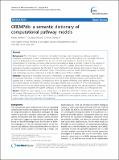| dc.contributor.author | Umeton, Renato | |
| dc.date.accessioned | 2012-04-24T20:04:50Z | |
| dc.date.available | 2012-04-24T20:04:50Z | |
| dc.date.issued | 2012-03 | |
| dc.identifier.issn | 1471-2105 | |
| dc.identifier.uri | http://hdl.handle.net/1721.1/70121 | |
| dc.description | From Eighth Annual Meeting of the Italian Society of Bioinformatics (BITS)
Pisa, Italy. 20-22 June 2011 | en_US |
| dc.description.abstract | Background The information coming from biomedical ontologies and computational pathway models is expanding continuously: research communities keep this process up and their advances are generally shared by means of dedicated resources published on the web. In fact, such models are shared to provide the characterization of molecular processes, while biomedical ontologies detail a semantic context to the majority of those pathways. Recent advances in both fields pave the way for a scalable information integration based on aggregate knowledge repositories, but the lack of overall standard formats impedes this progress. Indeed, having different objectives and different abstraction levels, most of these resources "speak" different languages. Semantic web technologies are here explored as a means to address some of these problems. Methods Employing an extensible collection of interpreters, we developed OREMP (Ontology Reasoning Engine for Molecular Pathways), a system that abstracts the information from different resources and combines them together into a coherent ontology. Continuing this effort we present OREMPdb; once different pathways are fed into OREMP, species are linked to the external ontologies referred and to reactions in which they participate. Exploiting these links, the system builds species-sets, which encapsulate species that operate together. Composing all of the reactions together, the system computes all of the reaction paths from-and-to all of the species-sets. Results OREMP has been applied to the curated branch of BioModels (2011/04/15 release) which overall contains 326 models, 9244 reactions, and 5636 species. OREMPdb is the semantic dictionary created as a result, which is made of 7360 species-sets. For each one of these sets, OREMPdb links the original pathway and the link to the original paper where this information first appeared. | en_US |
| dc.description.sponsorship | Università degli studi della Calabria (PhD student fellowship) | en_US |
| dc.description.sponsorship | Singapore-MIT Alliance for Research and Technology (Program in Computational and Systems Biology) | en_US |
| dc.description.sponsorship | Università di Catania | en_US |
| dc.publisher | BioMed Central Ltd | en_US |
| dc.relation.isversionof | http://www.biomedcentral.com/1471-2105/13/S4/S6/abstract | en_US |
| dc.rights | Creative Commons Attribution | en_US |
| dc.rights.uri | http://creativecommons.org/licenses/by/2.0 | en_US |
| dc.source | BioMed Central Ltd | en_US |
| dc.title | OREMPdb: a semantic dictionary of computational pathway models | en_US |
| dc.type | Article | en_US |
| dc.identifier.citation | Umeton, Renato, Giuseppe Nicosia, and C Forbes Dewey. “OREMPdb: a Semantic Dictionary of Computational Pathway Models.” BMC Bioinformatics 13.Suppl 4 (2012): S6. Web. | en_US |
| dc.contributor.department | Massachusetts Institute of Technology. Department of Biological Engineering | en_US |
| dc.contributor.mitauthor | Dewey, C. Forbes | |
| dc.contributor.mitauthor | Umeton, Renato | |
| dc.relation.journal | BMC Bioinformatics | en_US |
| dc.eprint.version | Final published version | en_US |
| dc.type.uri | http://purl.org/eprint/type/JournalArticle | en_US |
| eprint.status | http://purl.org/eprint/status/PeerReviewed | en_US |
| dc.date.updated | 2012-03-28T11:05:44Z | |
| dc.language.rfc3066 | en | |
| dc.rights.holder | et al.; licensee BioMed Central Ltd. | |
| dspace.orderedauthors | Umeton, Renato; Nicosia, Giuseppe; Dewey, C. Forbes | en_US |
| dc.identifier.orcid | https://orcid.org/0000-0001-7387-3572 | |
| dspace.mitauthor.error | true | |
| mit.license | PUBLISHER_CC | en_US |
| mit.metadata.status | Complete | |
